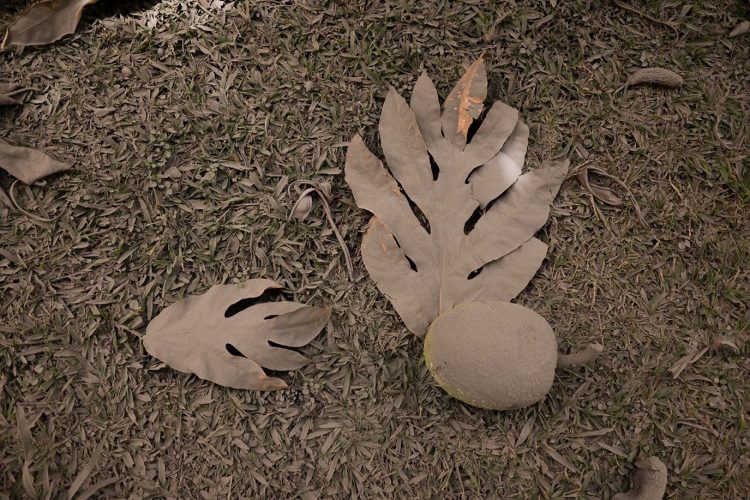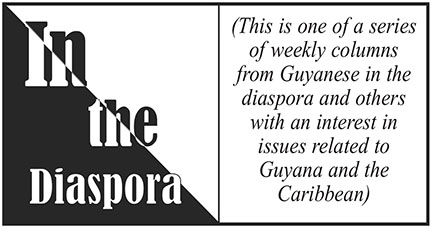By Kimberly J. Palmer and Adrian Fraser
Kimberly Palmer was born and raised in St. Vincent and the Grenadines (SVG), and received her PhD in Environmental Studies from York University in Toronto, Canada. Her interdisciplinary research spans the fields of Latin American and Caribbean Studies, cultural anthropology and social geography, and her doctoral dissertation focussed on Garifuna resistance to dispossession in Honduras. She is currently an Independent Researcher based in St. Vincent.
Adrian Fraser is a social commentator, historian, author, and columnist with the Searchlight newspaper; former Coordinator of the Caribbean Peoples’ Development Agency and Retired Head of the University of the West Indies Open Campus, St. Vincent and the Grenadines
In the Garifuna language the island of St. Vincent is known as Yurumein, the Garifuna homeland. The Garifuna or Garinagu (plural) – referred to as the “Black Caribs” in colonial accounts – are an Afro-Indigenous group whose ethnogenesis can be traced back to the island. The Garinagu’s African ancestors have largely been assumed to be survivors of two slave ships shipwrecked off the coast of St. Vincent in the mid 17th century, although Garifuna oral transcripts and regional historians draw attention to the improbability of what is sometimes called the “shipwreck thesis.” The Garinagu’s Kalinago ancestors were the native inhabitants of Yurumein when the Europeans arrived, and were misnamed as the “Caribs” “Island Caribs” or “Red / Yellow Caribs” by the British.

The British and French, in their effort to break the Spanish monopoly and colonise the Eastern Caribbean islands, had to contend with the fierce resistance of the indigenous people, including the Garinagu of St. Vincent. The two European powers thought it in their best interest from the 1660s to agree on treaties of neutrality, accepting the reality that St. Vincent, Dominica, Tobago, and St. Lucia belonged to the native peoples. Despite this, the Kalinago – who had developed a close relationship with the French – allowed some of their farmers and a few missionaries to settle with them on the western and southern areas of St. Vincent. It is said that the French had helped to resolve disputes between the Kalinago and Garinagu and had drawn a line of demarcation, giving the more numerically dominant Garinagu control over the northern and north eastern section of the island. There are also scholars who suggest that these two “Carib” groups did not see themselves as distinct, and that Kalinago and Garinagu were united by a common language and culture of resistance to slavery. It was instead the colonizers who sought to create racialized and spatialized distinctions between the two groups as a strategy of conquest.
When the British finally took control of St. Vincent following the 1763 Treaty of Paris, they were limited to the areas that were occupied by the Kalinago and French. They were aware that the lands occupied by the Garinagu were the ones best suited to the production of sugar, hence their determination to get rid of them. This led to a lengthy struggle that cumulated in the first and second Carib Wars. Garifuna resistance to the plantocracy was dealt a harsh blow in 1796, when Garifuna Paramount Chief Joseph Chatoyer was ambushed and killed by British troops near the present-day capital of Kingstown. Around 4000 Garinagu were captured by the British and transported to what amounted to an open-air concentration camp, the arid island of Balliceaux in the Grenadines. Over 2000 Garinagu perished on Balliceaux island. In 1797, the survivors of Balliceaux were exiled to Roatan in the Bay Islands, located in the present-day Republic of Honduras.
Despite the genocidal intent of the British, the exiled Garinagu survived in Central America, maintaining the Garifuna language and culture across the Caribbean littorals of Honduras, Guatemala, Belize and Nicaragua to this day. Their survival on the Isthmus was a struggle against almost all odds: from 1797 until presently the Central American Garinagu have suffered near constant attacks on their lives and identity. They have survived centuries of state-sanctioned massacres, forced displacements and social, political and economic exclusion. The Honduran Garinagu, especially, have been increasingly and violently dispossessed of their ancestral lands since the 2009 US and Canadian-backed coup d’état. As a result, Honduran Garinagu increasingly form parts of migrant “caravans” leaving Central America for the US border.
During the 1797 exile, some Garinagu were able to escape British persecution and hide in the mountainous interior and northern section of St. Vincent. A number of Kalinago also remained on the island post-1797, with one community receiving a land grant at Morne Ronde in the northwestern reaches of St. Vincent. The Garinagu at Greiggs in southern St. Vincent also received a land grant. Indigenous peoples were allowed to settle in the former Garifuna territory in the northeast of St. Vincent, as a solution to the labour needs of the British estates that had been established there. The 1902 eruption of the La Soufriere volcano, which dominates the northern third of the island, devastated the indigenous communities in the northwest and northeast of St. Vincent. Over two thousand persons perished during the eruption, many of them indigenous. Afterwards, the “Morne Ronde Caribs” were largely resettled at Rose Bank, further down the western coast of the island.
La Soufriere erupted twice again in the 20th century. An “effusive” eruption in 1971-72 eventually led to a larger “explosive” eruption months before SVG gained independence in 1979. On December 27th, 2020, La Soufriere awoke from her slumber. A months-long effusive eruption was a gradual rousing from a 41-year sleep. A slow emission of sticky magma and acidic gases formed a new dome in the volcano’s crater and gradually burned to a crisp the foliage and traditional marijuana farms located on the higher altitudes of the volcano’s western slopes. Communities in the designated “red zone” of the island were told to prepare for evacuation as an explosive eruption was imminent. The “red zone” is comprised of the areas of St. Vincent closest to the volcano, and is also indigenous space. It is home to approximately 20 000 mostly indigenous persons and is the area of the country that experiences the highest rates of poverty.
On April 8th, 2021, SVG’s Prime Minister Dr. Ralph Gonsalves held two emergency press conferences together with Prof. Richard Robertson from the University of the West Indies (UWI) Seismic Research Center. There had been a change in volcanic activity at La Soufriere, and the second press conference put into motion the official evacuation of the red zone. Thousands of people evacuated northern St. Vincent, with and without government assistance, well into the early hours of Friday morning. On the morning of April 9th, 2021, La Soufriere assured everyone that she was wide awake. Two massive explosive eruptions shot ash plumes kilometers into the sky that Friday. Explosive events continued for the better part of two weeks.
As we write this article, the volcano is settling down but we remain in the midst of crisis: thousands of people remain displaced from the red zone, and are now staying in emergency shelters and private homes in the southern safe or “green zone”. Government shelters were largely unprepared for the arrival of evacuees despite months of warning from the scientists. There have been Covid-19 outbreaks. Farmlands in the north of the island have been destroyed and will take a long time to recover. Food crops buried in feet of ash, and the traditional marijuana industry is now a stark, grey landscape. Infrastructure in the red zone has taken a severe beating from the combination of ash, pyroclastic flows and ongoing lahars / mud flows. Many persons from within the red zone communities have suffered devastating losses of property. As we take account of the damage, a host of conversations and debates are ongoing around the future of the red zone communities.
A critical review of recent history plays an important role in these ongoing conversations around resettlement and rebuilding the red zone communities. Indigenous displacement and resettlement schemes related to the 1902 eruption, for example, has arguably played a significant role in the erosion of indigenous culture in SVG post-exile. In 1902, the Morne Ronde Caribs petitioned the King of England and complained about their resettlement at Rose Bank, drawing attention to the fact that the location was not one that they had chosen / preferred, as it was not suitable for the continuation of their ancestral farming and fishing practices. Furthermore, the lands they received there were issued as individual small plots, a form of land tenure entirely contrary to their traditional, collective land tenure arrangements.
The 2020-2021 eruption of La Soufriere is the first time we will confront a disaster of this scale in post-Independence St. Vincent and the Grenadines. On SVG’s NBC radio on April 25th, SVG’s Prime Minister Dr. Ralph Gonsalves stated that red zone residents in St Vincent will be allowed to return to their homes once the eruption is over and the “all clear is given.” He also said that lands are being identified to relocate any evacuee who so desires this option. Senator Shevern Lewis-John, of Garifuna descent, also stressed that rebuilding must be considered carefully, and in dialogue with the Physical Planning department. She raised the point that indigenous communities had deep ties to places in the north of St. Vincent – which are critical to their material, cultural and spiritual survival. Going forward it is thus crucial to ask: how will lands be chosen for resettlement? Will indigenous communities be meaningfully involved, and will those lands be suitable for the continuation of their land and sea-based cultural practices and identity? In terms of rebuilding, what input will the communities have? And, what assistance will the most vulnerable in our society receive, in order to be able to construct homes that meet physical planning requirements and codes, and in order to not suffer disproportionately from another volcanic event?
In closing, it is important to recall the role of the diasporic Garifuna in cultural revitalization projects here in SVG, and the role played by our indigenous communities and their lands in the maintenance of the Garifuna culture outside of SVG. Increasingly over the past decades, Central American Garinagu return to the sacred homeland of Yurumein, visiting Garifuna and Kalinago communities and historical sites, and making the pilgrimage to Balliceaux island. The diasporic Garifuna have played a critical role in a number of projects centred on the recuperation of Garifuna identity, culture and language in Yurumein. It is vital that we pay close attention to what is at stake in how we recover from, resettle and rebuild after this recent eruption. The displacement of the Garinagu from their lands in the red zone during the 2021 eruption in St. Vincent, coupled with the ongoing threat of the sale of a privatized Balliceaux and the dispossession of the Honduran Garinagu, holds massive implications for the survival of the Garifuna people as a whole. The survival and strengthening of the Garifuna culture across the homeland and diaspora depends upon access and relationships to sites like Balliceaux island in the Grenadines, to the lands in Central America that the Garinagu have inhabited for over 224 years, and to indigenous spaces and places in northern Yurumein.








